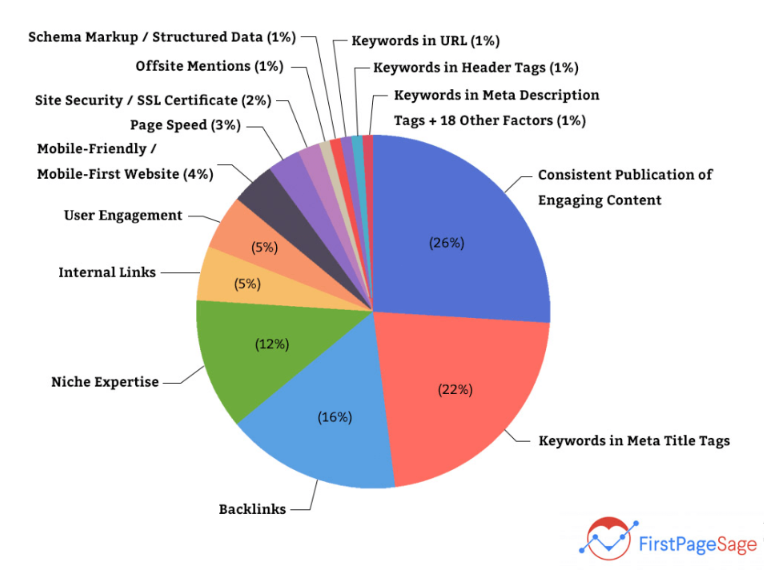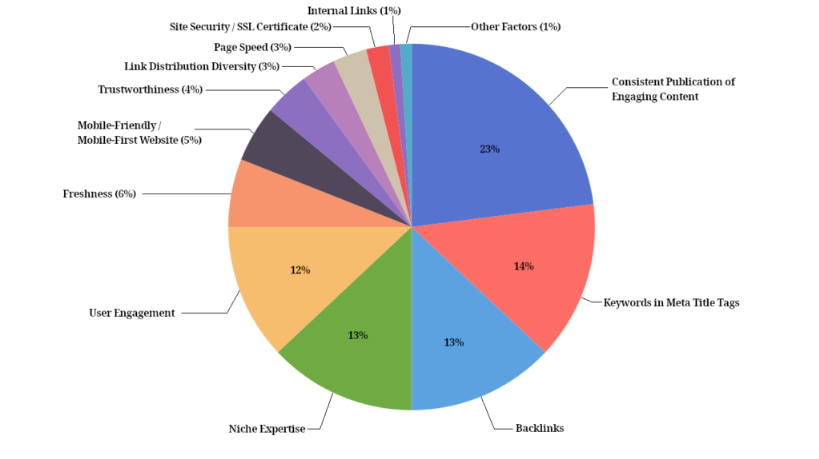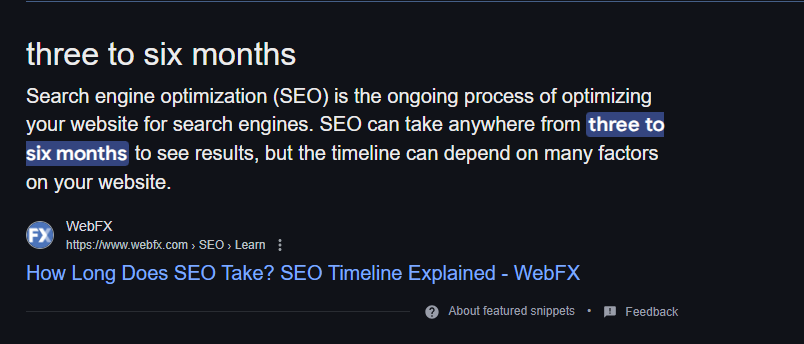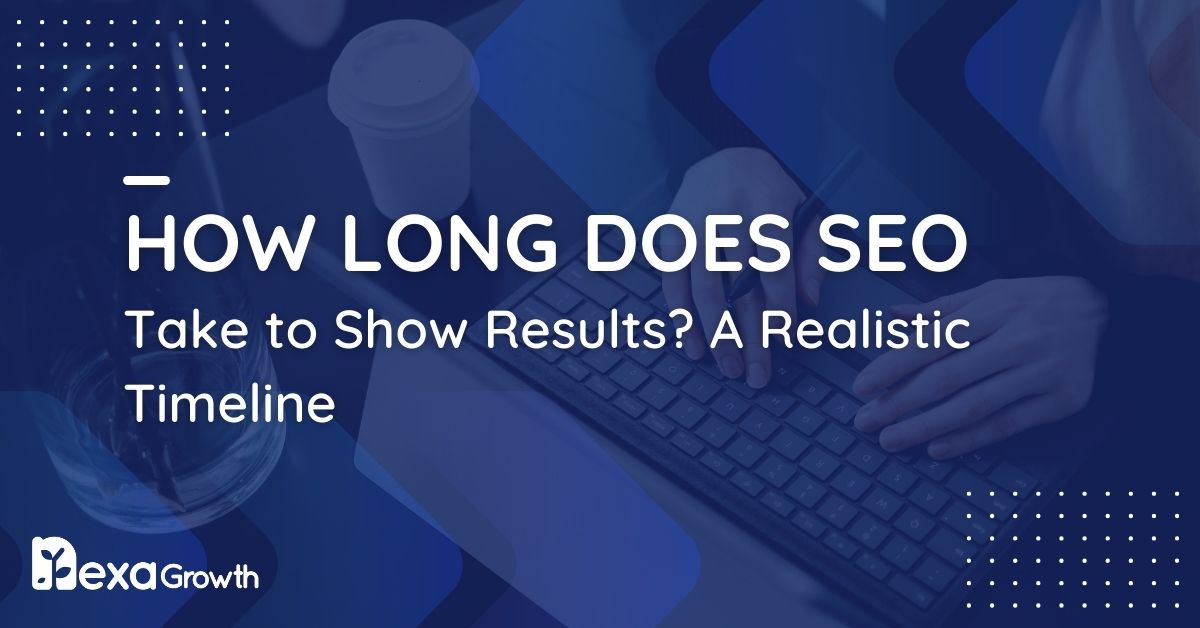- SEO is a long-term strategy, with most new pages taking at least a year to rank on Google’s first page.
- The time it takes is influenced by Google’s complex algorithm and the need to build trust and authority over time.
- A structured approach, such as a six-month action plan, can help accelerate results.
- The plan includes foundational work, on-page optimization, backlink building, and content expansion.
- Consistency is crucial for success, and SEO provides compounding results that deliver long-term value.
Here’s the million-dollar question: How long does SEO take to show results?
You’ve optimized your site, published high-quality content, built backlinks, and yet… nothing. No instant traffic surge, no first-page rankings, and definitely no leads pouring in overnight.
So, how long does SEO really take to show results?
According to a study by Ahrefs, 95% of newly published pages take at least a year to reach the first page of Google—if they ever get there at all.
Another report by Backlinko found that the average top-ranking page is over two years old. That’s right—SEO is a long game.
But here’s the good news: while SEO isn’t instant, it’s one of the most powerful and cost-effective marketing channels in the long run.
Unlike paid ads, where traffic disappears the moment you stop spending, SEO delivers compounding results over time—if done right.
So, if you’re wondering:
- Why does SEO take so long?
- What factors influence your SEO timeline?
- How can you speed up the process without cutting corners?
You’re in the right place.
This guide breaks down the exact timeline for SEO success, the key ranking factors at play, and proven strategies to get results faster.
By the end, you’ll have a clear, data-backed understanding of what to expect—and how to make SEO work for you.
Future-Ready SEO
We don’t just follow trends—we set them. Nexa Growth’s innovative SEO strategies keep your business ahead of the curve.
Contact UsWhy Does SEO Take So Long?
SEO isn’t slow just for the sake of it. It’s slow because search engines like Google prioritize trust, authority, and user experience—none of which can be built overnight.
Unlike paid ads, where you can bid your way to the top, organic rankings have to be earned through consistency and credibility.
Here’s why SEO takes time:
-
Google’s Algorithm Is Complex and Ever-Changing
- Google uses over 200 ranking factors to evaluate websites.

Google’s Ranking Factors- An Infographic by FirstPageSage - AI-driven updates, like Google’s Helpful Content and SpamBrain, continuously refine what ranks and what doesn’t.
- Sites must demonstrate relevance, authority, and trust (E-E-A-T) over time.
- Google uses over 200 ranking factors to evaluate websites.
-
SEO Is a Competition, Not Just Optimization
- If you’re in a competitive industry, you’re not just optimizing your site—you’re trying to outperform competitors who may have years of SEO momentum.
- High-authority sites (like Forbes, HubSpot, or Moz) dominate search results because they’ve built a strong reputation over time.
-
Trust and Authority Aren’t Instant
-
- Google doesn’t just trust a new website because it exists.
- Backlinks, brand mentions, and engagement signals accumulate gradually, signaling credibility.
- Sites with strong domain history have an edge over new ones starting from scratch.
-
-
Google Needs Time to Crawl, Index, and Rank Your Content
- Just because you publish a page today doesn’t mean Google will rank it tomorrow.
- Search engines must discover, crawl, index, and then evaluate your content against competitors before deciding where to rank it.
- The more efficient your technical SEO, the faster this process can happen.
-
SEO Success Relies on Consistency
- One great piece of content won’t move the needle—SEO requires a sustained effort.
- Google favors sites that publish fresh, authoritative content consistently over time.
- Building internal links, refining on-page SEO, and acquiring backlinks are ongoing efforts.
How Long Should You Expect to Wait?
While no one can guarantee a timeline, most SEO experts agree on these rough estimates:
- 0-3 Months → Website indexing, technical fixes, and foundational content creation. Minimal ranking improvements.
- 3-6 Months → Initial ranking movements for lower-competition keywords. Organic traffic begins to trickle in.
- 6-12 Months → Competitive keywords start ranking. Traffic increases steadily.
- 12+ Months → Strong ranking positions, higher domain authority, and compounding traffic growth.
SEO is not an overnight win, but when done correctly, it can deliver sustainable, long-term results that outperform paid ads in cost-effectiveness.
Next, let’s break down the key factors that influence how long your SEO results will take.
Featured Article: The History of SEO: Evolution Over the Years
Key Factors That Influence How Long SEO Takes
No two websites follow the same SEO timeline. Some businesses start seeing results in months, while others take over a year to gain traction.
Why? Because SEO success depends on multiple factors—some within your control, others dictated by competition and Google’s ever-evolving algorithm.

Let’s break down the biggest factors that determine how long it takes to see SEO results.
-
Your Website’s History and Authority
Older, more established websites generally rank faster than brand-new domains. Here’s why:
- Domain Age and Authority – Older domains with a strong backlink profile have an advantage in Google’s trust algorithm.
- Past SEO Performance – If your site has previously ranked well, it’s easier to regain traction.
- Google Penalties – If your site has been hit by algorithm updates or manual penalties in the past, recovery can take months.
💡 Fast-Track Tip: If you’re working with a new website, focus on building authority early by securing high-quality backlinks and publishing trustworthy, in-depth content consistently.
-
Competition in Your Industry
SEO isn’t just about your website—it’s about how strong your competitors are. Some industries are easier to rank in than others.
- Low-Competition Niches → You can rank in a few months.
- Highly Competitive Niches → It could take a year or more to break into page one.
- Big Brands Dominate? → You’ll need a more strategic approach, targeting long-tail keywords and niche topics.
💡 Fast-Track Tip: Instead of going head-to-head with industry giants, focus on ranking for less competitive, long-tail keywords first.
-
Your SEO Strategy and Execution
SEO success isn’t just about what you do—it’s about how well you do it.
- Are you consistently publishing high-quality content?
- Are you optimizing for search intent, not just keywords?
- Are you earning authoritative backlinks, not spammy ones?
💡 Fast-Track Tip: A clear SEO strategy with well-defined goals, keyword targets, and execution timelines will get you results faster.
-
Keyword Difficulty and Search Intent
Some keywords are easier to rank for than others. The more competitive the keyword, the longer it takes to rank.
- Low-difficulty, long-tail keywords → Rank within months.
- High-difficulty, short-tail keywords → Could take 12+ months to rank.
- Transactional vs. Informational Search Intent – Google prioritizes different types of content for different searches.
💡 Fast-Track Tip: Start by ranking for easier keywords first to gain traction before targeting the heavyweights.
-
Technical SEO and Site Health
A well-optimized site gets indexed and ranked faster than a site with technical issues.
- Site Speed and Core Web Vitals – Google prioritizes fast, mobile-friendly websites.
- Crawlability and Indexability – Ensure Google can easily find and index your content.
- Structured Data and Schema Markup – Helps search engines understand your content better.
💡 Fast-Track Tip: Run a technical SEO audit (via Google Search Console, Screaming Frog, or Ahrefs) and fix any crawl errors, slow pages, or indexing issues.
-
Content Quality and Freshness
Not all content is created equal. Google favors content that is:
- In-depth & well-researched – Thin content won’t cut it.
- Regularly updated – Freshness matters for competitive queries.
- Optimized for E-E-A-T – Content should demonstrate Experience, Expertise, Authority, and Trustworthiness.
💡 Fast-Track Tip: Refresh old content and repurpose it into new formats (videos, infographics, podcasts) to increase visibility.
-
Backlink Profile and Authority Building
Google sees backlinks as votes of confidence—but quality matters more than quantity.
- High-Authority Links → Faster ranking improvements.
- Spammy Links → Can trigger penalties, hurting rankings.
- Natural Link-Building → Google prefers links earned through valuable content and outreach, not black-hat tactics.
💡 Fast-Track Tip: Focus on earning editorial links from trusted sources (guest posting, PR, HARO, digital partnerships).
-
User Engagement and Behavior Signals
Google tracks how users interact with your site to determine if it’s worth ranking higher.
- Bounce Rate – If users leave your site immediately, it signals poor relevance.
- Dwell Time – Longer time spent on your site = better content quality.
- Click-Through Rate (CTR) – Higher CTR on search results = more relevance.
💡 Fast-Track Tip: Optimize your title tags and meta descriptions to improve CTR and keep visitors engaged with better UX and compelling content.
Rank Higher. Get Found. Grow Faster.
Nexa Growth’s expert SEO strategies help you climb search rankings, drive traffic, and boost your business.
Contact UsFeatured Article: SEO Success in 2025: Metrics, Audits & Strategies for Long-Term Growth
How to Get SEO Results Faster (Without Cutting Corners)
SEO is a long game, but that doesn’t mean you have to sit back and wait for months before seeing progress.
There are proven strategies that can help you gain traction faster—without using black-hat tactics that could get your site penalized.
Here’s how to accelerate your SEO success the right way.
-
Target Low-Competition, High-Intent Keywords
One of the biggest mistakes businesses make is going after high-volume, high-competition keywords right away. Instead, focus on low-hanging fruit that can get you rankings faster.
- Use tools like Ahrefs, SEMrush, or Google Keyword Planner to find low-competition keywords.
- Prioritize long-tail keywords (e.g., “how to optimize a blog post for SEO” instead of “SEO optimization”).
- Choose keywords with high purchase intent for better conversion rates.
💡 Example: Instead of targeting “digital marketing,” go for “digital marketing for small businesses in the UK.”
-
Optimize for Featured Snippets and Zero-Click Searches
Google increasingly favors featured snippets, People Also Ask (PAA) boxes and quick answers—and ranking for these can put you at the top of search results instantly.

An Example of a Zero-Click Search - Use bullet points and numbered lists to structure content for snippets.
- Answer common questions directly within your content.
- Use schema markup (FAQ, How-To, Review) to increase visibility.
💡 Example: If you’re targeting “How long does SEO take?”—provide a direct answer within the first 100 words to increase your chances of winning a snippet.
-
Leverage Internal Linking for Faster Crawling and Ranking
Google follows links to discover and index new pages, so strategic internal linking can speed up rankings.
- Link to high-authority pages within your site to distribute link equity.
- Use descriptive anchor text that includes relevant keywords.
- Avoid orphan pages—every page should be linked to at least one other page.
💡 Example: A new blog post about SEO timelines should link to older, high-ranking posts on keyword research, backlinks, and on-page SEO.
-
Ensure Your Pages Are Indexed Quickly
Even the best content won’t rank if Google doesn’t know it exists. Speed up indexation with these tactics:
- Submit new URLs manually via Google Search Console.
- Use Google’s Indexing API (for jobs, live events, or fresh content updates).
- Ensure your sitemap is up to date and submitted in Search Console.
- Eliminate crawl errors that may be blocking pages from being indexed.
💡 Example: If you publish a new blog post, request indexing in Google Search Console instead of waiting for Google to find it naturally.
-
Refresh and Repurpose Old Content
Old, outdated content drags down your rankings—but refreshing it can boost organic traffic without creating brand-new content from scratch.
- Update statistics, case studies, and examples to keep content fresh.
- Expand thin content by adding more depth, FAQs, and expert insights.
- Merge similar articles that are competing for the same keyword (SEO cannibalization fix).
💡 Example: If you have an article titled “SEO Strategies 2023,” update it to “SEO Strategies 2025” with new insights, and republish with a fresh date.
-
Build High-Quality Backlinks Early
Backlinks remain one of Google’s strongest ranking factors. However, quality matters more than quantity—so focus on earning authoritative links naturally.
- Guest posting on reputable industry sites.
- HARO (Help a Reporter Out) for PR mentions and backlinks.
- Creating data-driven or unique research content that others want to link to.
- Broken link building—find broken links on competitor sites and suggest your content as a replacement.
💡 Example: Instead of buying spammy backlinks, focus on earning links from authoritative domains in your industry (e.g., Forbes, HubSpot, industry blogs).
-
Improve Core Web Vitals and Page Speed
Google’s Core Web Vitals update prioritizes fast, user-friendly experiences. If your site is slow, rankings will suffer—no matter how good your content is.
- Compress images and enable lazy loading.
- Use a content delivery network (CDN) for faster load times.
- Optimize JavaScript and CSS to reduce render-blocking issues.
- Enable browser caching for repeat visitors.
💡 Example: Run your site through Google PageSpeed Insights and fix high-impact issues first (like large image files or server response times).
-
Focus on User Engagement and On-Page SEO
Google tracks how users interact with your site. The better your engagement metrics, the higher your rankings.
- Improve title tags and meta descriptions for higher CTR.
- Use engaging visuals like infographics and videos to keep users on the page.
- Structure content with short paragraphs, subheadings, and bullet points to improve readability.
- Encourage social sharing to increase organic reach.
💡 Example: A blog post with engaging visuals, interactive elements, and clear CTAs will perform better than a plain text article.
Featured Article: The Role of SEO in Digital Marketing: Why It’s Essential for Success
How to Improve Your SEO Timeline
Many businesses struggle with slow SEO results because they lack a clear, structured plan. Instead of waiting passively, you can accelerate your SEO progress by following a well-defined roadmap.
Below, we have created a a six-month action plan to improve rankings and increase organic traffic efficiently.
Month 1: Laying the Technical and Strategic Foundation
The first month is all about setting up your website for long-term SEO success. Without a strong foundation, even the best content and backlinks won’t deliver results.
- Conduct a comprehensive SEO audit to identify technical issues, slow-loading pages, and indexing problems.
- Perform in-depth keyword research to target a mix of high-value, long-tail, and low-competition keywords.
- Optimize your site architecture by improving URL structures, internal linking, and mobile usability.
- Set up Google Search Console and Google Analytics to track performance and troubleshoot issues.
Primary Goal: Ensure your website is technically sound and ready for SEO growth.
Month 2: Strengthening On-Page Optimization and Content
Once technical issues are resolved, the focus shifts to on-page SEO and content development to improve rankings and visibility.
- Optimize existing pages by refining meta titles, descriptions, headers, and internal links.
- Create cornerstone content—in-depth, high-value articles targeting your core keywords.
- Implement structured data (schema markup) to improve how search engines interpret your content.
- Identify and fix any indexing issues preventing pages from appearing in search results.
Primary Goal: Strengthen content quality and on-page optimization to improve search rankings.
Month 3: Establishing Authority Through Backlinks and Internal Linking
SEO isn’t just about optimizing your site—it’s also about earning trust and authority through backlinks and internal link-building.
- Start outreach campaigns for guest posting, PR mentions, and high-quality backlinks.
- Use HARO (Help a Reporter Out) to get featured in news articles and industry blogs.
- Optimize for featured snippets and People Also Ask (PAA) sections by structuring content for easy search engine parsing.
- Improve internal linking to distribute link authority and enhance crawlability.
Primary Goal: Build domain authority through quality backlinks and strong internal linking.
Month 4: Expanding Content and Enhancing User Experience
By this stage, your website should be ranking for some low-competition keywords. Now it’s time to scale content production and improve user engagement.
- Publish more long-form, high-quality content to cover additional keyword variations.
- Refresh and update existing content by adding new statistics, case studies, and insights.
- Improve page speed, mobile usability, and Core Web Vitals to enhance the user experience.
- Analyze keyword performance and adjust content strategies accordingly.
Primary Goal: Expand content coverage and enhance user experience for better engagement and rankings.
Month 5: Competitive Analysis and Advanced Optimization
Now that your website is gaining traction, it’s time to refine your approach and gain a competitive edge.
- Conduct a competitive analysis to identify backlink opportunities and content gaps.
- Optimize content for secondary keywords to increase search visibility.
- Improve conversion rates by refining calls-to-action (CTAs) and optimizing landing pages.
- Strengthen E-E-A-T signals (Experience, Expertise, Authority, Trustworthiness) with expert contributions and citations.
Primary Goal: Analyze competitor strategies and optimize content for long-term success.
Month 6: Scaling SEO Efforts for Long-Term Growth
SEO is an ongoing process, and by month six, your strategy should focus on maintaining and scaling growth.
- Expand content clusters by creating supporting pages around high-ranking topics.
- Conduct a backlink audit to remove toxic links and acquire new high-authority backlinks.
- Develop an ongoing content calendar to ensure fresh content is published consistently.
- Monitor Google algorithm updates and adjust your SEO strategy accordingly.
Primary Goal: Scale content, strengthen backlinks, and refine strategy for sustained SEO growth.
SEO success depends on strategy, execution, and consistency. By following this six-month timeline, you can accelerate rankings, drive traffic, and build a sustainable organic growth strategy.
- Focus on technical SEO and keyword research in the early months.
- Strengthen on-page optimization and authority-building in the mid-stage.
- Scale content production and refine strategy as rankings improve.
SEO isn’t an overnight success, but with a structured plan, you can achieve faster, measurable results and turn organic search into a long-term business asset.
Climb the Rankings, Stay on Top
With Nexa Growth’s proven SEO strategies, you don’t just rank—you dominate. Let’s get you noticed!
Contact UsFeatured Article: SEO vs. SEM: What’s the Difference & Which One Is Right for You?
Should You Stop SEO If You’re Not Seeing Results?
Many businesses get frustrated and quit SEO too soon—right before they start seeing real results.
When Should You Keep Going?
- Your organic traffic is slowly increasing.
- Rankings are improving, even if conversions haven’t taken off yet.
- You’re gaining high-quality backlinks and brand mentions.
- Google is indexing your pages faster than before.
When Should You Pivot Your SEO Strategy?
- No ranking improvements after 6+ months (reassess keyword strategy).
- Google penalties or traffic drops (audit your backlink profile and technical SEO).
- Targeting the wrong audience (revise your content and keyword strategy).
💡 Bottom Line: SEO is a long-term investment. Stopping too soon means leaving rankings, traffic, and potential revenue on the table.
How to Make SEO a Profitable Investment
SEO isn’t just about ranking—it’s about building a sustainable, long-term traffic source that drives business growth.
Key Takeaways
- SEO takes time, but the results are worth it.
- Targeting the right keywords, optimizing content, and earning quality backlinks can speed up results.
- Consistency is key—SEO is a marathon, not a sprint.
- Avoid black-hat tactics that may lead to Google penalties.
- Monitor analytics and adjust your strategy based on real data.
Next Steps
If you’re serious about SEO success, focus on building authority, creating valuable content, and optimizing your site for both users and search engines.
Need Help Accelerating Your SEO Growth?
Work with experienced SEO experts who can guide your strategy and execution. The sooner you start, the sooner you’ll see results.
Contact UsConclusion
If there’s one thing to take away from this guide, it’s this: SEO is an investment, not an expense. It takes time, effort, and strategic execution to see results, but once those rankings start compounding, the benefits far outweigh the wait.
Unlike paid advertising—where traffic disappears the moment you stop spending—SEO delivers sustainable, long-term visibility that continues to grow over time.

